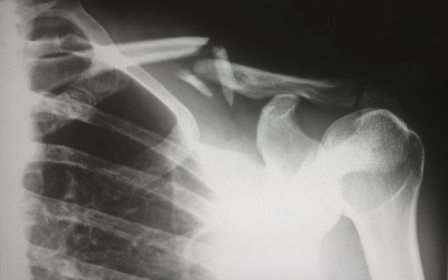
“I love talking about my shoulders,” said Raymond Verville of Burlington.
That wasn’t always the case. Verville had pain in his shoulders for years, but thought he was too old for surgery. Finally, unhappy about not being able to do things like dry his back after a shower, he went to see Dr. John Macy. In December of 2009, at age 78, he underwent shoulder replacement surgery. “Five days later, I was feeling so good I was crying,” he said. “I went back six weeks later to get the second one done. I never had the slightest bit of pain from the procedure.”
Macy is an orthopedic surgeon based in South Burlington whose specialty is shoulder and elbow problems. In May he gave a presentation at the Doubletree Hotel before an enthusiastic audience of 75 people on “Understanding Chronic Shoulder Pain.” Macy was impressed at how knowledgeable the audience was. “It was a varied crowd,” he said “and they asked great questions.”
While shoulder problems can come in many varieties, Macy said the most common are those involving the rotator cuff. There are three stages of rotator cuff disease: early stage which is inflammation, tendonitis or bursitis; middle in which the tendon is partially torn; and late stage which is characterized by a full rotator cuff tear. Each stage can be symptomatic or asymptomatic and not every tear needs to be repaired. Ideally, treatment for rotator cuff injuries is non-operative, requiring activity modification, anti-inflammatories and physical therapy to regain a full range of motion. If that doesn’t work, it’s best to have surgery as early as possible because tears can get worse over time and smaller tears are easier to repair. The earlier the surgery is conducted, the less the chance the tear will reopen.
Macy said rotator cuff injuries can’t necessarily be prevented because some occur due to intrinsic tendon disease, which is genetic. External factors can include exposure to overhead activities such as swimming, tennis or throwing. Macy said studies have shown that 30-50 percent of those over the age of 50 have partial or full rotator cuff tears. “It’s a very high incidence,” he said “but that doesn’t necessarily mean they are all symptomatic. We treat those who are symptomatic because that causes disability, dysfunction, weakness and pain.”
Recovery from rotator cuff surgery usually requires a patient to be immobilized for four to six weeks. Physical therapy is initiated after a week and can last for two to three months. A full recovery may take six to nine months. “I tell all my patients,” said Macy, “that rotator cuff surgery is the longest rehab process and can take up to a year for a full recovery, but most patients are doing well after three months.”
Another frequent shoulder problem is arthritis, although it is significantly less common than knee or hip arthritis. Like rotator cuff injuries, arthritic shoulders can be treated non-operatively with activity modification, anti-inflammatories and physical therapy. Macy said the importance of physical therapy cannot be overstated. “If you have knee or hip surgery, you can walk afterwards,” he said, “but you don’t use your shoulder or arm as much, particularly if it hurts. We need to almost force people to use the joint, and that requires therapy.”
Cortisone shots can also be used as treatment, but Macy doesn’t recommend more than three annually because of possible side effects.
Brynn Kusiak, a physical therapist at the Edge in Williston, works with patients with shoulder injuries. For those who have not had surgery, Kusiak said it is important to learn how long they have had pain, what positions make them feel better and what makes them feel worse. An important consideration is posture, which Kusiak described as a major aspect of muscle pain. Symptoms can be treated with heat, ice, ultrasound, electrical stimulation and progressive exercise including stretching and strengthening programs. Patients are encouraged to develop a home exercise regime, as well.
Post-operative rehab programs are very similar. Kusiak said it is important to have “early movement” after surgery, even if it is just passive motion that a patient does at home.
“We try to help them manage,” she said. “We try to get them exercising within their comfort range and sometimes we help them stretch beyond what they think they can do.”
Kusiak noted that the shoulder is unique because use of it “involves the coordinated movements of the ball and socket joint, shoulder blade, collar-bone, and the joints, ligaments, tendons, and muscles that connect through the whole region.” For this reason, shoulder rehabilitation is a longer, more complex and more challenging process than that required for many other types of injuries.
Although roughly 600,000 knee and hip replacements are performed by doctors annually, the number of shoulder replacements is much lower; 30,000-40,000 annually. While most orthopedic surgeons perform no more than two to four shoulder replacements annually, Macy does close to 100. He describes the operation as quicker and easier than rotator cuff surgery. Full recovery may take nine months to a year, but most patients spend three weeks in a sling. Within three months after the operation, they can do most of their regular activities. Macy said over 90 percent of rotator cuff surgery and shoulder replacement surgery is successful in the short and long-term.
Kusiak believes the increasing level of activity in older people is leading to more shoulder injuries. “Shoulders are very vulnerable,” she said. It may take longer for an older person to heal, but the rehab regimen should not be appreciably different than a younger person.
Among the sports which can create the most shoulder problems are baseball, golf, sailing, swimming and tennis. Kusiak noted that both kayakers and canoers are susceptible to shoulder injuries, but flat water kayakers can return to form faster than canoers because they don’t reach as high. “People should prepare for sports ahead of time,” said Kusiak. “There should be a combination of stretching, strengthening, and awareness of posture, as well as some sport-specific exercises. Two to three times a week everyone should do something to maintain their strength to avoid injury.”
Kusiak cautions older athletes to ease into their athletic endeavors. “You need to gradually work into things,” she said, “and make sure to warm up before and cool down afterwards.”
“I keep thinking it’s a miracle,” said Verville. He underwent four months of physical therapy which he supplemented by working out at home. “I felt so good,” he said “that I just had heart surgery. Now that I’ve got two good shoulders I wanted to make sure my ticker would work.”
This article was contributed by Phyl Newbeck.
 Related Articles & Free Subscription
Related Articles & Free Subscription
Massage and Reiki: Relax, De-stress, Be Happy






Comment here